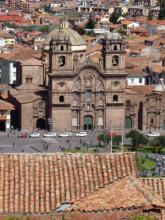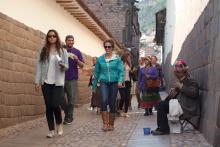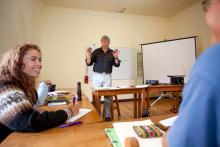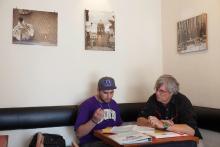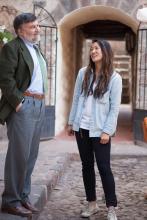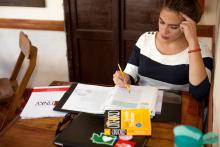The students stood one by one to take their turns reading, the intricate stonework of Machu Picchu rising majestically behind, a sheer rock face before them plunging down to the Urubamba River shimmering 400 meters below. We had come to the “Lost City of the Incas” to read aloud Pablo Neruda’s magnificent epic of modern man’s encounter with Ancient America, Alturas de Machu Picchu (The Heights of Machu Picchu). Fourteen students on the first Spanish Department program to Cusco, Peru dedicated their reading to the Chilean Nobel Laureate and to la Pachamama, the Incan Earth Mother.
This was the final activity of the first half of the program in which the group had taken either: Intensive Spanish 201 with me (Anthony Geist); or Spanish 202 with local teacher Viviana Pujada; as well as Art History (Spanish 299) taught by Cusco artist, María Elena Mendoza. Mendoza uses the streets and monuments of Cusco and the surrounding area as the textbook for the class, exploring Incan architecture, pottery and weaving before the arrival of the Spaniards. The group is now studying Colonial art and history and the class will continue throughout the second half of the program, covering such topics as the extraordinary work of the early 20th century photographer Martín Chambi, as well as visits to the studios and galleries of contemporary cusqueño artists.
Students also perform required service learning, offering a variety of workshops in local schools as well as working with a school for the blind and helping a young polio victim with his English and his physical rehabilitation. Students, David Chen and Kristen Kendall reflected on their placement with a school for disabled children: “It is an incredible privilege to witness the dedication of those who work there and humbling to catch a glimpse of the lives of the children…Our presence is very useful because otherwise these kids would have little experience of people our age.”
As I write, the students are on a weeklong travel-study break between the two halves of the program. Most of them have gone to the Manu wilderness in the Peruvian Amazon. On their return to Cusco they will take either Spanish 202 or 203 in addition to the continuation of Art History.
Our partner institution, Centro Tinku, provides classrooms and arranges all excursions, including the Sacred Valley, Machu Picchu, the weaving cooperative in Chinchero, and Puno and Lake Titicaca on the border with Bolivia. They also arrange homestays. Each student lives in a private room with a host family, one student per family, and takes all meals with the Peruvian family.
Student, Caity Cunningham has this to say about her living arrangement: “I watch American crime shows dubbed into Spanish on TV with my host mom, which is cool because it helps me learn conversational expressions. My Peruvian brothers don’t live at home so my mom and I have bonded in this way.”
The Cusco program replaces the longstanding departmental program in Oaxaca, Mexico, which has seen its enrollments dwindle precipitously in recent years. We chose Cusco because it offers many of the same attractions as Oaxaca: a rich pre-Hispanic history and archeological sites, a vibrant contemporary indigenous culture, a lively arts scene, and of course access to one of the wonders of the world, Machu Picchu.
The Cusco program is designed to run every autumn quarter and is open to all UW students who have completed either Spanish 103 or 201. Junior Harrison Warner has these words of advice for any student considering applying to the program: “Any place you go you won’t regret, but Peru has so much to offer. It’s a perfect example of colonial expansion. Unlike in the US, here you see both cultures, the indigenous and the European. Being in Cusco puts you in the center.
You can go to the beaches on the coast, to the Amazon jungle, or to the mountains for hiking and adventure. People are warm and welcoming when you get to know them. And the nightlife is great!”
Anthony L. Geist, Resident Director.
Back to Fall 2012 Newsletter
